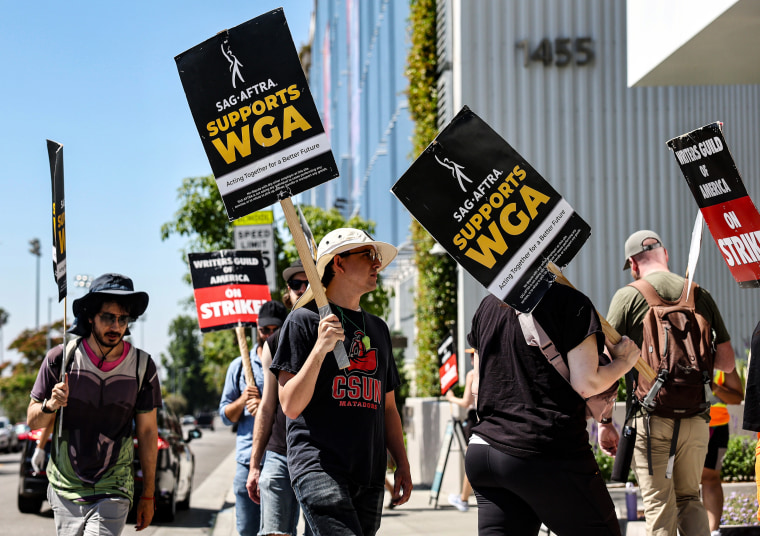WGA And SAG-AFTRA Strike: A Complete Guide To The Hollywood Shutdown

Table of Contents
Understanding the Causes of the WGA and SAG-AFTRA Strike
The WGA and SAG-AFTRA strikes, while separate, share common threads concerning fair compensation, working conditions, and the impact of new technologies. Both unions are fighting for a more equitable future in a rapidly changing entertainment landscape.
WGA Strike Key Issues:
The WGA strike centers around several key issues impacting writers' livelihoods and creative control:
- Fair Wages in the Streaming Era: Traditional residuals, the payments writers receive for reruns and syndication, have plummeted with the rise of streaming. The WGA seeks a fairer system of compensation that reflects streaming viewership and revenue. This includes a fairer share of the profits generated from their work on popular streaming shows.
- Minimum Staffing Levels on Productions: "Mini-rooms" and reduced writing staffs have become common practice, leading to overworked writers and a decline in the quality of television programming. The WGA is advocating for mandated minimum staffing levels to ensure fair workloads and prevent exploitation.
- Protecting Writers' Rights in the Age of AI: The increasing use of AI in writing raises significant concerns about copyright infringement and the devaluation of human creativity. The WGA is demanding strong protections against unauthorized use of AI to generate scripts or other written material.
- Increased Residuals for Streaming Content: As mentioned, streaming services have drastically altered the revenue streams for writers. The WGA demands a substantial increase in residuals to compensate for the shift from traditional broadcast models.
- Transparency in Streaming Viewership Data: Streaming platforms often withhold crucial data about viewership, making it difficult for writers to negotiate fair compensation. The WGA is pushing for greater transparency to ensure fair compensation is tied to actual audience numbers.
SAG-AFTRA Strike Key Issues:
SAG-AFTRA's strike shares some concerns with the WGA, but also addresses issues specific to actors:
- Fair Wages and Residuals for Streaming and Other New Media: Similar to the WGA, SAG-AFTRA is fighting for fairer compensation in the streaming era, including increased residuals for streaming performances. This is crucial given the shift in how audiences consume media.
- Protecting Actors from the Use of AI: The use of AI to create digital doubles and alter actors' performances without their consent is a major concern. SAG-AFTRA seeks strong protections to prevent the exploitation of actors' likenesses and work through AI.
- Improved Health and Pension Benefits: Health and pension benefits for actors are crucial, particularly for those who experience periods of unemployment between projects. SAG-AFTRA is striving for improvements in these essential benefits.
- Regulation of Self-Tape Auditions and the Use of AI in Creating Digital Doubles: The industry's reliance on self-tape auditions and the increasing use of AI-generated doubles have created new challenges. SAG-AFTRA advocates for regulations to protect actors and prevent exploitation.
- Addressing the Power Imbalance Between Studios and Actors: The strike aims to address the significant power imbalance between large studios and individual actors, fostering a more equitable and respectful working relationship.
The Combined Impact of the Dual Strikes:
The simultaneous strikes by the WGA and SAG-AFTRA represent an unprecedented event in Hollywood history. The combined impact is staggering:
- Unprecedented Scale of the Industry Shutdown: Nearly all major film and television productions have been halted, creating a complete standstill across the industry.
- Ripple Effects Across Related Industries: The shutdown affects numerous related industries, including catering, transportation, and post-production, causing widespread economic disruption.
- Impact on the Upcoming Awards Season: The strike is already impacting the upcoming awards season, with potential delays and uncertainties around nominations and ceremonies.
The Impact of the WGA and SAG-AFTRA Strike on Hollywood
The effects of this dual strike are far-reaching and will likely be felt for months, if not years, to come.
Production Halt:
- Delays and Cancellations of Numerous Film and Television Projects: Many productions have been indefinitely delayed or canceled entirely, impacting timelines and budgets.
- Financial Losses for Studios and Production Companies: The production standstill is resulting in substantial financial losses for studios and production companies.
- Job Losses for Crew Members and Other Industry Professionals: Thousands of crew members, technicians, and other industry professionals are facing unemployment due to the shutdown.
Release Delays:
- Postponement of Movie and Television Show Releases: Numerous film and television releases have been postponed, creating uncertainty for studios and audiences alike.
- Impact on Streaming Content Schedules: Streaming platforms are also affected, with delays and disruptions in their content schedules.
- Uncertainty for Future Project Releases: The long-term impact on future project releases remains uncertain, with potential delays for years to come.
Economic Consequences:
- Effects on the Broader Economy, Particularly in Los Angeles and Surrounding Areas: The strike is having a significant impact on the economy of Los Angeles and surrounding areas, affecting businesses and individuals.
- Decreased Tourism and Revenue in Entertainment-Related Businesses: The shutdown is also affecting tourism and revenue in entertainment-related businesses, such as restaurants, hotels, and tourist attractions.
- Impact on the Stock Market Performance of Entertainment Companies: The strike has already had a noticeable impact on the stock market performance of major entertainment companies.
Potential Outcomes and Resolutions of the WGA and SAG-AFTRA Strike
Resolving this complex situation requires navigating numerous challenges.
Negotiation Challenges:
- The Complex Nature of Contract Negotiations Between the Unions and the AMPTP (Alliance of Motion Picture and Television Producers): Negotiations are inherently complex, involving multiple parties with diverse interests and priorities.
- The Differing Priorities and Strategies of the Various Parties Involved: Reaching a consensus requires addressing the differing priorities and strategies of the unions and the AMPTP.
- Potential for Long-Term Stalemate: The possibility of a protracted strike with significant long-term consequences for the industry remains a significant concern.
Possible Scenarios:
- Successful Negotiation of a Fair Contract Addressing the Unions' Key Concerns: A successful resolution would involve a fair contract addressing the unions' key concerns regarding fair compensation, working conditions, and the use of AI.
- A Prolonged Strike with Significant Long-Term Consequences for the Industry: A prolonged strike could have severe and lasting consequences for the entire industry, including financial losses, job losses, and creative stagnation.
- Compromises and Incremental Changes Made Over Time: A compromise might involve incremental changes and a phased approach to addressing the various issues raised by the unions.
The Role of Public Opinion:
- The Importance of Public Support for the Striking Workers: Public support is crucial for the success of the strikes, helping to put pressure on the AMPTP to negotiate fairly.
- The Influence of Media Coverage on the Negotiations: Media coverage plays a significant role in shaping public opinion and influencing the negotiations.
- The Power of Consumer Boycotts: Consumer boycotts of studios and streaming services could also put pressure on the AMPTP to reach a settlement.
Conclusion:
The WGA and SAG-AFTRA strike represents a pivotal moment in the history of Hollywood, highlighting crucial issues regarding fair compensation, working conditions, and the impact of evolving technology. The outcome will significantly shape the future of the entertainment industry. Understanding the complexities of this strike, from its root causes to its potential resolutions, is vital for anyone invested in the future of filmmaking and television. Stay informed about the ongoing WGA and SAG-AFTRA strike, and support fair labor practices in the entertainment industry. Keep checking back for updates on the WGA and SAG-AFTRA strike and its impact on Hollywood. The future of the WGA and SAG-AFTRA strike and its impact remains uncertain, but one thing is clear: the fight for fair compensation and working conditions in the entertainment industry is far from over.

Featured Posts
-
 76 2 0
May 08, 2025
76 2 0
May 08, 2025 -
 Superman Injured Sneak Peek Reveals Kryptos Role
May 08, 2025
Superman Injured Sneak Peek Reveals Kryptos Role
May 08, 2025 -
 Wall Street In Kripto Para Goeruesue Degisiyor Yeni Bir Doenem Mi
May 08, 2025
Wall Street In Kripto Para Goeruesue Degisiyor Yeni Bir Doenem Mi
May 08, 2025 -
 Jayson Tatum Takes A Hilarious Hit From Tnt Announcers In Abc Promo
May 08, 2025
Jayson Tatum Takes A Hilarious Hit From Tnt Announcers In Abc Promo
May 08, 2025 -
 Billionaires Top Pick The Etf Predicted To Soar 110 By 2025
May 08, 2025
Billionaires Top Pick The Etf Predicted To Soar 110 By 2025
May 08, 2025
